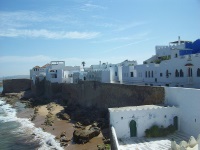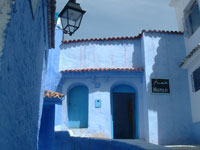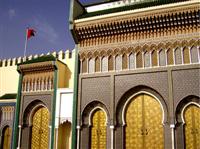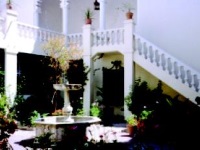
The fishing village of Asilah, south of Tangier, has become a popular seaside resort because of its nearby Paradise Beach, relaxing ambience, and picturesque, 15th-century, Andalusian medina, which extends to the sea wall. Asilah is characterised by picturesque white buildings reminiscent of Santorini, but with a dash of Moroccan flavour.The town has a long and fascinating history, dating back to 1500BC, and it was not always as peaceful as it is now: in the 19th and 20th centuries Asilah was a notorious base for pirates, and from 1912 to 1956 it was occupied by the Spanish. The ramparts and gateworks designed to fortify the old town against invaders of old are still intact.Getting around Asilah is easy enough, with feet being the best mode of transport, although donkey carts are also a fun option. Asilah is accessible from Tangier by train and coastal road. Asilah is fairly quiet for most of the year, except when artists and performers descend for the Asilah Arts Festival each August. The resort town hosts several other arts and music festivals, including a mural-painting festival which ensures that the town's walls remain covered in striking paintings all year.

Chefchouen is a magical little town up in the Rif Mountains, just a short drive from Tangier. The town as an interesting heritage, as it was a home to Spanish refugees in the middle ages, and took in Christian and Jewish refugees alike as the centuries progressed - all of these influences come to bear on visitors' experience of Chefchouen today.The medina of Chefcouen isrenowned as one of the most charming in Morocco, with whitewashed, gabled houses and blue-rinsed buildings where craftsmen sit in their shops sewing caftans and embroidering jellabahs. The medina is dominated by the 17th century Great Mosque, which fronts a picturesque square dotted with mulberry trees and inviting restaurants. The square is also surrounded by souks selling carpets, leather goods, pottery and copper ware. While Chefchaouen has enough picturesque Moroccan charm to attract droves of tourists, another aspect of its popularity is its reputation for recreational drug use (it is the centre of a marijuana and hashish producing region).Probably the best thing to do here is hike. One of the best places to trek to is the tiny, traditional village of Kalaa, hiding in the hills outside Chefchaouen. Here one can relax in the remote serenity of rural Moroccan life that has changed little over the centuries. The village is also a wonderful base for exploring the Rif Mountains and hikes can be arranged to other local villages in the area and all the way to the Mediterranean. As tourism increases more villagers are opening their doors to the trade and new guest houses are springing up in the area.

A collection of art from all over Morocco is housed in the imposing Dar el Makhzen, a former sultan's palace dating from the 17th century.The art collections are housed in the prince's apartments, which are breathtaking with frescoed ceilings, sculptured plasterwork and intricate mosaics. The art on display has been assembled from all regions of Morocco, and includes firearms decorated with marquetry, pottery, carpets from Rabat, silks, and bound manuscripts from Fez. The Dar el Makhzen palace is home, too, to a fascinating museum of antiquities relating to Morocco's pre-history, gathered from archaeological sites such as Lixus, Cotta and Volubilis. The museum includes a lifesized model of a Carthaginian tomb, and a reproduction of an ancient necropolis, which is situated in a peaceful Andalusian garden.This palace is not to be confused with the Dar el Makhzen in Fez, which is famous for its stunning golden doors and intricately carved and tiled gateway, but is not open to the public. The Sultan's Palace in Tangier is situated on one of the highest points of the city and therefore affords visitors some glorious views and excellent photographic opportunities.

The word socco is the Spanish version of souk, meaning market, and has stuck to this square in the heart of Tangier because of its Spanish heritage.The square is, however, no longer a marketplace, but rather a city crossroads and huge taxi rank, fronted by cafés, outside the fortified old part of the city. The Grand Socco has developed something of a reputation for being a meeting place for criminals and drug dealers, but it is still an interesting spot to spend time watching the passing parade, particularly the Rif women in colourful traditional costume touting vegetables and fresh mint. It is also the hop off point for entry to the medina, for admiring the luxurious Mendoubia Gardens on the north side, and the mosaic-studded minaret of the Sidi Bou Abid Mosque to the west.The Grand Socco is particularly active at night, when food stalls and second-hand goods stores pop up and the square takes on some of its traditional function as a market, and tourists should be vigilant and should not openly display wealth; however, the crime in the Grand Socco is generally petty and opportunistic.

In the midst of the old medina in Tangier, the US has provided a thriving cultural centre, museum, conference venue and library in the only historic landmark of the United States that is located abroad.The American Legation Museum is housed in the American Embassy, established in Tangier soon after Morocco became the first power to recognise the United States of America as an independent country in 1777; the Moroccan ruler, Sid Suleiman, gifted the US this building in 1821. Although the sultan presented such buildings to a number of countries, the US is the only one to have held onto the property until the present day. The museum houses art collections, restored historic rooms, and a number of permanent exhibitions.The American Legation Museum is one of the most popular attractions in Tangier and well worth a visit, particularly as entrance is free, but it should not demand too much time - an hour or two is sufficient for most visitors. For many American tourists it is fascinating to explore the first official representation of their country overseas. Guided tours are offered and the curator/tour guide is a font of knowledge, but it is possible to explore on your own.
Website : www.legation.org

Travel Guide powered by Word Travels, copyright © 2023 Globe Media Ltd. By its very nature information in this travel guide is subject to change at short notice and travellers are urged to verify information on which they're relying with the relevant authorities. Neither Globe Media Ltd nor Travel Vogue can accept any responsibility for any loss or inconvenience to any person as a result of information contained above.